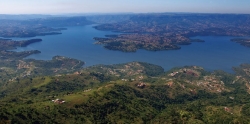The Warmest Place To Be:Durban\'s Tourism Human Touch Theory2013-05-06 Although communication technology on the African continent is on a par with the best in the world, Phillip Sithole, Head of Business Support and Tourism, is of the opinion that the best form of communication with a potential visitor to your city or country is by ‘human touch’. It allows people to interact with each other and conveys tourism experiences to the visitor first hand.
Research has shown that the rest of Africa loves visiting Durban. Wealthy Nigerians and Tanzanians are often repeat visitors to the city and they spend lots of money here. This is part of the reason why Durban Tourism is focusing on Africa as an emerging market for the city. Presently the biggest inflow of tourists is from the SADC region so, in the next three years countries beyond this region will be the main focus. Research by SA Tourism has revealed that the African traveller spends R2 500 per day when visiting South Africa. This amount is over and above the average R17 000 that they spend on shopping, per visit. Durban is branded as ‘The warmest place to be’. This tagline does not only refer to the climate but also to the people who are friendly and welcoming. The city offers visitors a number of tourism nodes â€" historical, cultural, lifestyle, heritage and wildlife â€" a palette of diversity. The most prominent historical route is the Inanda Heritage Route which was once home to Mahatma Gandhi for 18 years. John Dube, a former President of the ANC, lived in this area as well. During this time he shared the idea of a free South Africa with Gandhi and Isiah Shembe, a religious leader who started the Shembe movement. Many African leaders, both past and present, have made the so called ‘pilgrimage’ to the Inanda Heritage Route. In fact, when The Reverend Jesse Jackson visited South Africa in 2010 he insisted that his trip would not be complete without visiting this historical route. Once again the theme of ‘human touch’ comes into play. Past President Nelson Mandela found this route so inspirational during The Struggle that he decided to cast his first democratic vote at the John Dube Institute located on the Inanda Heritage Route. In promoting this concept Durban Tourism will be providing tours to these nodes for the African Renaissance delegates. Local operators have also embraced the concept of human touch and will be on standby during the festival to share their experiences with the delegates on short, custom-made tours to various nodes within the city of Durban. Phillip Sithole and his team plan to extend their concept of the human touch in its marketing endeavours into the rest of Africa in the promotion of Durban as a tourist destination. National Geographic recently sent a camera crew to produce a 30 minute documentary on Durban. The historic premiering of this documentary took place on the 1 May 2013 and was watched by 363 million people across 160 countries. The core of the documentary is about the people and their culture, something that National Geographic felt was a uniquely Durban characteristic. Our city was also successfully branded prior to the release of the documentary at the National Geographic store in London. Here we were able to successfully practise the theory of human touch by engaging with visitors to the store on a one-on-one basis. |
The Warmest Place To Be:Durban\'s Tourism Human Touch Theory
Copyright © 2024 KwaZulu-Natal Top Business
